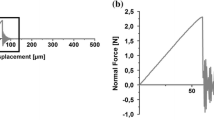Abstract
Cold forging is a group of methods effectively used in a number of industrial applications to form aluminium. Tool life and complexity of the possible shapes are mainly restricted by galling; the uneven tool surfaces caused by lumps of transferred material lead to surface damage on successive parts formed and/or problems in successive forming operations, and high stresses occurring when forming complex shapes. Earlier investigations have shown that improved surface roughness of an uncoated steel tool decreases the amount of adhered aluminium on the tool, but does not decrease the friction in the long run. Testing has also shown that when using conventional forming tools it is very important to have sufficient lubrication to avoid galling. Addition of an optimized low-friction PVD-coating decreases the galling tendency and increases the tolerance to insufficient lubrication and lubricant film breakthrough, as long as the coating surface is smooth, whilst other similar coatings have little or no effect. The present article further investigates the mechanism behind the transfer of aluminium to the coatings. All coatings were found to be intact after testing, and so the differences were concluded to lie in the chemical properties of the coating and, if these are favourable, then in surface roughness on the micro scale.




















Similar content being viewed by others
References
Lange, K.: Handbook of Metal Forming. McGraw-Hill, New York (1985)
Liu, H., Yuan, J.L., Jin, J.: Visualization simulations for a cold press die. J. Mater. Process. Technol. 129, 321–325 (2002)
Mattson, S.: SIS Handbok 12, Aluminium. SIS Förlag AB, Stockholm, (2001) (in Swedish)
Schmid, S.R., Wilson, R.D.: Tribology in manufacturing. In: Bhushan, B. (ed.) Modern Tribology Handbook, pp. 1385–1411. CRC, NY (2001)
Hanson, M.: On adhesion and galling in metal forming. PhD thesis, Uppsala University (2008)
Kim, H., Sung, J., Goodwin, F.E., Altan, T.: Investigation of galling in forming galvanized advanced high strength steels (AHSSs) using the twist compression test (TCT). J. Mater. Process. Technol. 205, 459–468 (2008)
Heinrichs, J., Jacobson, S.: Laboratory test simulation of galling in cold forming of aluminium. Wear 267, 2278–2286 (2009)
Heinrichs, J., Jacobson, S.: Laboratory test simulation of aluminium cold forming—influence from PVD tool coatings on the tendency to galling. Surf. Coat. Technol. 204, 3606–3613 (2010)
Bay, N.: The state of the art in cold forging lubrication. J. Mater. Process. Technol. 46, 19–40 (1994)
Podgornik, B., Hogmark, S., Pezdirnik, J.: Comparison between different test methods for evaluation of galling properties of surface engineered tool surfaces. Wear 257, 843–851 (2004)
Hanson, M., Gåård, A., Krakhmalev, P., Hogmark, S., Bergström, J.: Comparison of two test methods for evaluation of forming tool materials. Tribotest 14, 147–158 (2008)
Harlin, P., Bexell, U., Olsson, M.: Influence of surface topography of arc-deposited TiN and sputter-deposited WC/C coatings on the initial material transfer tendency and friction characteristics under dry sliding contact conditions. Surf. Coat. Technol. 203, 1748–1755 (2009)
Nylund, A., Olefjord, I.: Surface analysis of oxidized aluminium. Surf. Interf. Anal. 21, 283–289 (1994)
Wagner, C.D., Moulder, J.F., Davis, L.E., Riggs, W.M.: Handbook of X-Ray Photoelectron Spectroscopy. Perking-Elmer Corporation, Physical Electronics Division, Eden Prairie, MN (1979)
Acknowledgments
The authors wish to thank Steertec Raufoss and SINTEF Raufoss Manufacturing for the financial support through the programme BIP AluPart, partly financed by the Research Council of Norway, and for sharing their knowledge about the aluminium forming process. We also wish to thank the Swedish Foundation for Strategic Research for financial support via the programme Technical advancement through controlled tribofilms, Mikael Olsson for valuable discussions and comments on the manuscript, and finally Frida Riddar for education in operating the ESCA instrument and interpreting the spectra.
Author information
Authors and Affiliations
Corresponding author
Rights and permissions
About this article
Cite this article
Heinrichs, J., Jacobson, S. Mechanisms of Transfer of Aluminium to PVD-Coated Forming Tools. Tribol Lett 46, 299–312 (2012). https://doi.org/10.1007/s11249-012-9952-5
Received:
Accepted:
Published:
Issue Date:
DOI: https://doi.org/10.1007/s11249-012-9952-5



